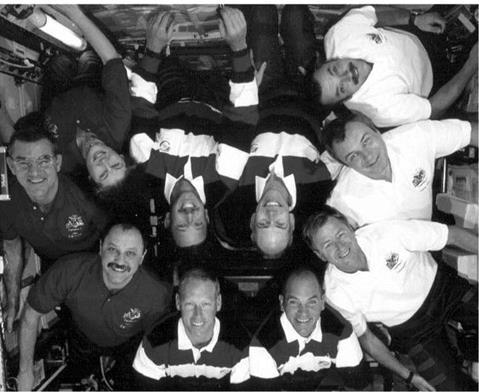STS-105
 2001-035A
2001-035A
10 August 2001
Pad 39A, Kennedy Space Center, Florida 22 August 2001
Runway 15, Shuttle Landing Facility, KSC, Florida OV-103 Discovery/ET-100/SRB BI-109/SSME #1 2052; #2 2044; #3 2045
11 days 21 hrs 13 min 52 sec Discovery
ISS assembly flight 7A.1; MPLM-1 logistics mission; delivery of ISS-3 crew; return of ISS-2 crew
Flight Crew
HOROWITZ, Scott Jay, 44, USAF, commander, 4th mission Previous missions: STS-75 (1996); STS-82 (1997); STS-101 (2000)
STURCKOW, Frederick Wilford, 41, USMC, pilot, 2nd mission Previous mission: STS-88 (1998)
FORRESTER, Patrick Graham, 44, USAF, mission specialist 1 BARRY, Daniel Thomas, 47, civilian, mission specialist 2, 3rd mission Previous missions: STS-72 (1996); STS-96 (1999)
ISS-3 crew up only:
CULBERTSON Jr., Frank Lee, 52, civilian, mission specialist 3, ISS-3
commander, 3rd mission
Previous missions: STS-38 (1990); STS-51 (1993)
TYURIN, Mikhail Vladislavovich, 41, civilian, Russian mission specialist 4, ISS-3 flight engineer
DEZHUROV, Vladimir Nikolayevich, 39, Russian Air Force, mission specialist 5, ISS-3 Soyuz commander, 2nd mission Previous mission: Soyuz TM21 (1995)
ISS-2 crew down only:
VOSS, James Shelton, 51, US Army, ISS-2 flight engineer 1, mission specialist 3, 5th mission
Previous missions: STS-44 (1991); STS-53 (1992); STS-69 (1995); STS-101 (2000) HELMS, Susan Jane, 42, USAF, ISS-2 flight engineer 2, mission specialist 4, 5th mission
Previous missions: STS-54 (1993); STS-64 (1994); STS-78 (1996); STS-101 (2000) USACHEV, Yuri Vladimirovich, 42, civilian, Russian ISS-2 and Soyuz commander, mission specialist 5, 4th mission
Previous missions: Soyuz TM18 (1994); Soyuz TM23 (1996); STS-101 (2000)
|
Inside Destiny, the crews of STS-105 and Expeditions 2 and 3 pose for a traditional in-flight joint crew portrait. On the left is the outgoing ISS-2 crew, in the centre is the STS-105 crew and to the right the incoming ISS-3 crew. From bottom right going clockwise: Sturckow and Forrester (both STS-105), Usachev, Voss and Helms (ISS-2 crew), Horowitz and Barry (both STS-105), and Tyurin, Dezhurov and Culbertson (ISS-3 crew) |
Flight Log
Lightning and thick cloud, together with the risk of showers led to the original launch attempt on 9 August being scrubbed. The threat of bad weather the next day meant the launch window was opened five minutes earlier and the mission launched without incident. Docking with ISS took place on FD 3 and Discovery would remain linked to the station for 188 hours. The Leonardo MPLM was moved across to ISS on FD 4, where it would be unloaded over several days. The cargo included 3,000 kg of equipment, supplies and material. There were 12 racks of experiments and equipment in the module, six of which were Re-supply Stowage Racks that carried equipment, clothing, food and supplies. There were also four Storage Re-supply Platforms for logistics supplies and hardware, and two Express Racks that included smaller payloads for delivery to the station. Old hardware and used equipment was moved back to Leonardo for the trip back to Earth. On this flight, the ISS-2 crew’s belongings were part of the return cargo. In total, some 1,360 kg of material was brought back to Earth.
Two EVAs (by Barry – EV1 and Forrester – EV2) were completed (16 Aug for 6 hours 16 minutes and 18 August for 5 hours 29 minutes), during which the Shuttle EVA crew installed the Early Ammonia Servicer (EAS), which included spare ammonia for use in the station’s coolant system if required. During the second EVA, the crew prepared for the delivery of the S0 Truss (planned for 2002) by installing heater cables and handrails on both sides of the Destiny lab. During FD 5, Discovery took over control of ISS while Zvezda received upgraded software from Russian flight control. The command of the station reverted to Zvezda when the new software had been loaded and checked.
Official hand-over between ISS-2 and ISS-3 crew members took place on FD 6 (17 Aug), which included a series of briefings and exchange of Soyuz seat liners in Soyuz TM32. Discovery undocked from ISS on 20 August and after the usual fly – around and separation manoeuvre, the Shuttle crew released a small science satellite, called Simplesat, by means of spring ejection from a GAS canister in the payload bay. The orbiter landed on the second of two Florida opportunities, with the first having been waived off due to bad weather.
Milestones
227th manned space flight
136th US manned space flight
106th Shuttle mission
30th flight of Discovery
50th US and 83rd flight with EVA operations
11th STS ISS mission
4th Discovery ISS mission
3rd MPLM flight
2nd MPLM 01 Leonardo flight
2nd Shuttle ISS resident crew exchange mission












